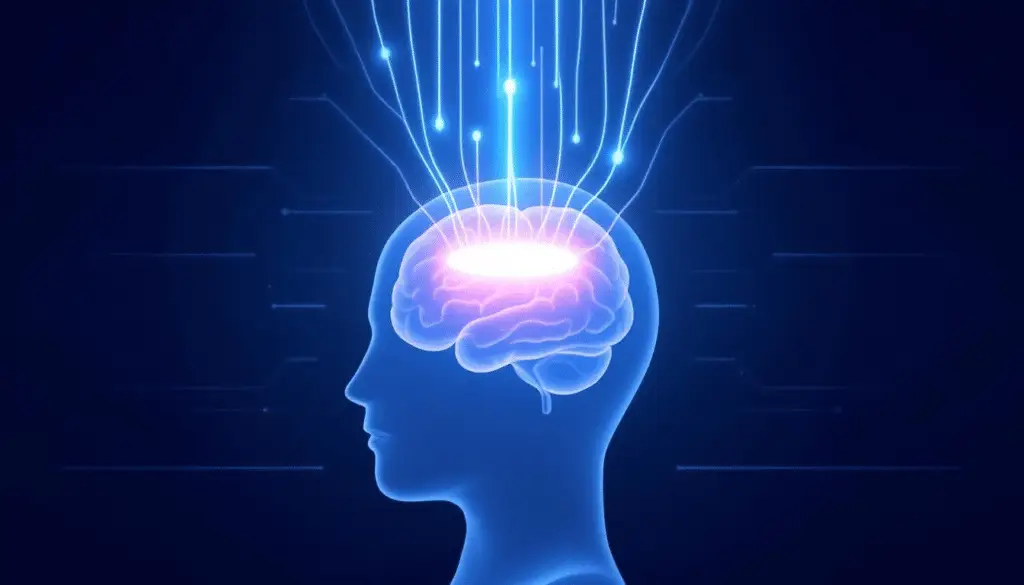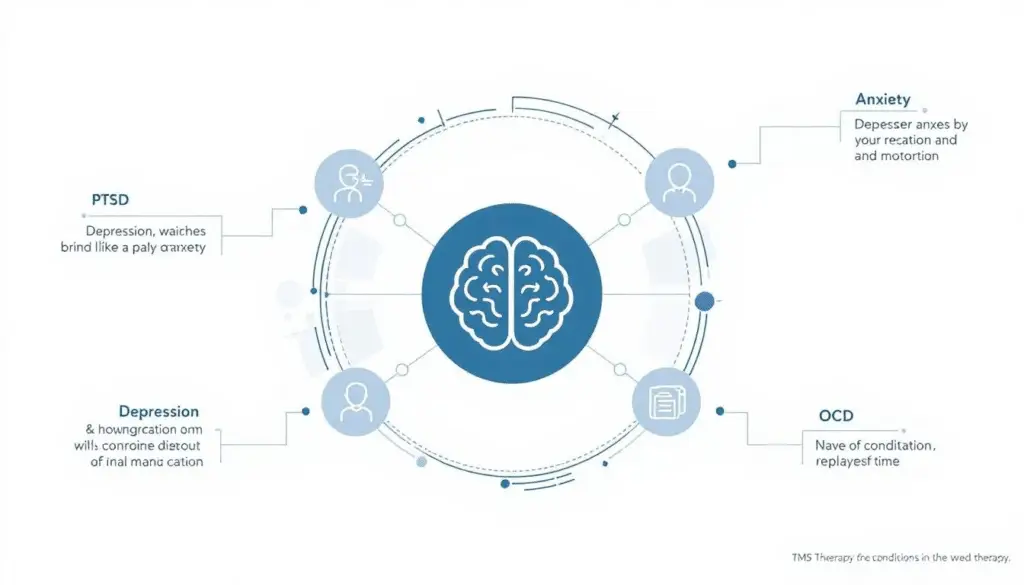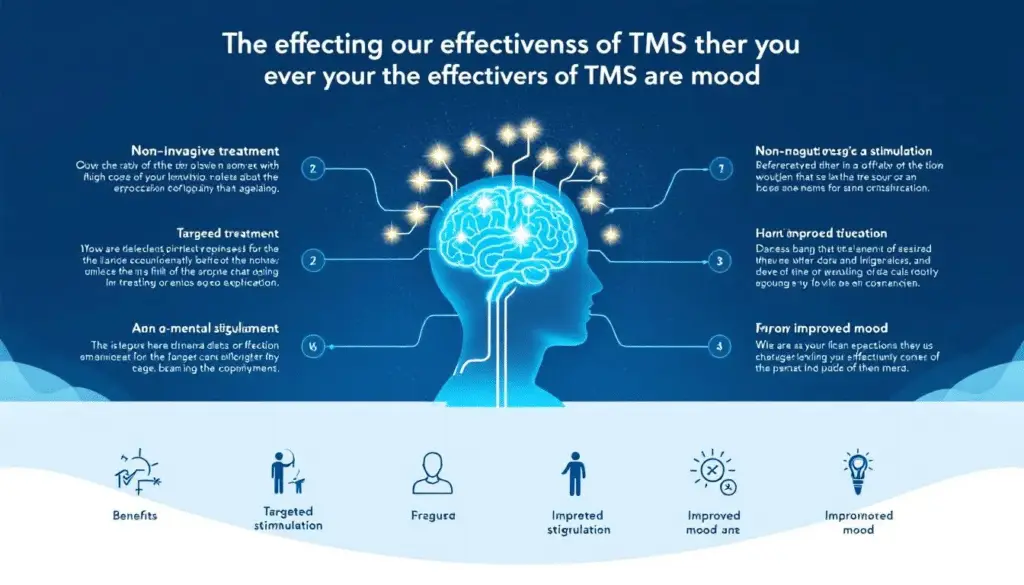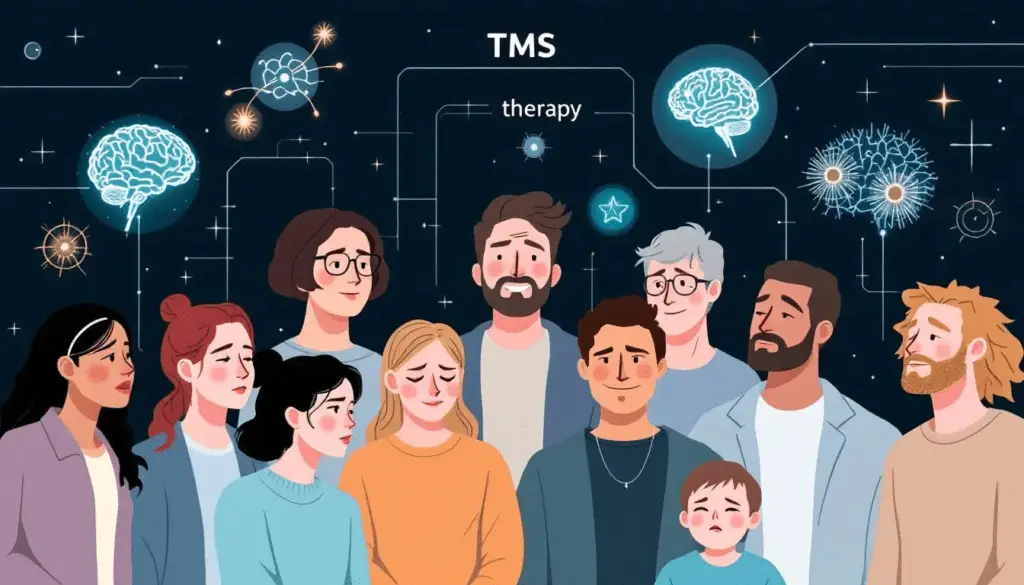TMS therapy is a noninvasive, drug-free option for treating depression and anxiety. For people who haven’t had success with traditional treatments, TMS offers a promising alternative. In this article, we’ll explore how TMS therapy works, its benefits, conditions it treats, and what you can expect during sessions.
Key Takeaways
TMS Therapy is a noninvasive, FDA-approved treatment for major depressive disorder, obsessive-compulsive disorder, and other conditions, offering an alternative for patients unresponsive to traditional therapies.
The therapy uses magnetic pulses to stimulate specific brain areas, with techniques like Deep TMS enhancing effectiveness, achieving response rates of up to 82% after 30 sessions.
TMS therapy is generally well-tolerated with mild side effects, and its accessibility is further increased as it is covered by many insurance plans and is suitable for adolescents aged 15 and older.
Understanding TMS Therapy

Transcranial Magnetic Stimulation (TMS) is a noninvasive, drug-free treatment for major depressive disorder (MDD) and obsessive-compulsive disorder (OCD). Unlike other brain stimulation therapies, TMS avoids surgery, anesthesia, and implanted devices, ensuring a safe and accessible option for many patients.
Repetitive TMS (rTMS) is particularly noted for delivering repeated magnetic pulses to activate underactive brain areas linked to mood control. The procedure involves:
Placing a TMS coil against the scalp
Generating magnetic fields that pass through the skull
Stimulating specific brain regions
Activating nerve cells
This treatment option is a game-changer for those who have not responded well to traditional psychiatric and neurological disorder therapies.
How TMS Works
Transcranial Magnetic Stimulation (TMS) leverages an electromagnetic coil to produce magnetic fields that stimulate a specific brain region. During treatment, these magnetic pulses target the brain region associated with mood regulation, alleviating symptoms of depression. The process is noninvasive and allows for precise targeting of brain regions without the need for surgery or anesthesia, including repetitive transcranial magnetic stimulation.
Deep TMS (dTMS) advances this technology by using a specialized coil that reaches deeper brain structures compared to standard rTMS. Adjustments in stimulation intensity and duration enhance the neuromodulatory effects of TMS, ensuring patients receive the most effective care with deep brain stimulators.
Conditions Treated by TMS

Transcranial Magnetic Stimulation (TMS) has FDA approved status for treating major depression, especially for patients unresponsive to traditional therapies. This makes it a valuable option for those with treatment-resistant depression, significantly improving recovery chances. Deep TMS has also received FDA approval for treating Obsessive-Compulsive Disorder (OCD), offering hope to those who have not found relief through conventional treatments.
Beyond depression and OCD, TMS is approved for treating migraines and shows promise in aiding smoking cessation. Conditions like chronic pain and PTSD might also benefit, showcasing TMS’s versatility and potential to improve lives.
The First TMS Session
Your first TMS appointment marks a crucial step in your treatment journey. It starts with determining your motor threshold to establish the necessary energy level. This involves mapping the magnet’s placement in the right location and setting the appropriate magnetic energy dose. Expect to meet with a psychiatrist, sit in a reclining chair, and wear a cap for threshold mapping.
During the initial session, you’ll experience:
A tapping sensation as the TMS coil is placed on your head.
The procedure is noninvasive.
Patients are typically asked to wear earplugs due to the loud clicking sounds produced by the machine.
The initial treatment dose is often set lower to help you adjust to the sensation.
Remove all metallic objects before starting the TMS procedure to ensure safety. The session typically lasts about an hour, allowing time for initial mapping and necessary adjustments. This preparation ensures your TMS therapy is safe and effective from the start.
What to Expect During TMS Sessions
After the first session, subsequent TMS treatments become more routine, involving similar procedures and adjustments as needed. Patients will hear a clicking sound and feel a tapping sensation on the scalp. Some may experience scalp discomfort or pain, but these usually subside during pauses.
The duration of TMS sessions can vary:
The initial session lasts about an hour.
Subsequent sessions can be much shorter.
The latest technique, intermittent theta burst stimulation, completes a session in approximately 3.5 minutes.
Most patients can resume their daily activities immediately after treatment, making it convenient for busy schedules.
Your provider may adjust treatment based on symptoms or side effects, ensuring each treatment session is tailored to your specific needs and maximizing therapy effectiveness.
Frequency and Duration of TMS Treatments
TMS treatment sessions are typically conducted as follows:
Daily, five times a week
Frequency often ranges from 3 to 5 times per week, depending on the protocol
Each session generally lasts less than 20 minutes, although the duration can vary based on the technique used
The standard duration of a TMS treatment course for conditions like depression is generally six weeks, although some patients may notice improvements in just a few weeks. This period allows for multiple sessions to achieve optimal effects. Frequent and consistent sessions are crucial for the success of TMS therapy, ensuring long-term symptom relief.
Effectiveness of TMS Therapy

TMS therapy is backed by promising results:
Response rates for repetitive TMS (rTMS) are about 50%, with over 30% of patients achieving complete remission.
Deep TMS (dTMS) shows even higher efficacy, with 82% responding and 65% reaching remission after 30 sessions.
Intermittent Theta-Burst Stimulation (iTBS) produces similar response and remission rates to rTMS, often with a longer-lasting effect. This is part of the rTMS treatment series.
One exciting advancement in TMS therapy is the SAINT protocol, using fMRI for precise targeting, reporting a response rate of 86% and a remission rate of 79% for treatment-resistant depression. Compared to traditional antidepressant medications, TMS generally has higher success rates and quicker symptom relief.
These durable effects can lead to long-term symptom reduction, offering hope to many individuals struggling with other mental health conditions.
Side Effects of TMS
Transcranial Magnetic Stimulation (TMS) is generally safe and well-tolerated, with side effects typically mild to moderate. Common side effects include scalp discomfort, headaches, and facial muscle twitching, usually temporary and manageable with over-the-counter pain medicine.
Unlike Electroconvulsive Therapy (ECT), TMS does not cause significant cognitive impairment or memory loss. Serious complications like seizures are rare but can occur. To minimize discomfort, healthcare providers can adjust the stimulation level during TMS sessions.
Proper ear protection prevents hearing issues during treatment. This favorable safety profile makes TMS an attractive option for many patients, especially when considering hearing protection.
Who Can Benefit from TMS?

Transcranial Magnetic Stimulation (TMS) therapy is beneficial for individuals with treatment-resistant depression, including those unresponsive to psychotherapy or antidepressant medications. TMS is available for adolescents, with evolving FDA guidance indicating its safety. At UMass Memorial Health, adolescents aged 15 and older are eligible for TMS therapy.
TMS therapy helps individuals with depression and certain anxiety disorders by stimulating specific brain regions. Most insurance companies cover TMS therapy, making it accessible to many patients. This inclusive approach ensures a wide range of individuals can benefit from this innovative treatment.
Contraindications for TMS
While TMS is safe and effective for many, it is not suitable for everyone. TMS therapy is not recommended for patients with epilepsy, pre-existing neurological diseases, and those with metallic or electronic implants. Specifically, individuals with metal implants in close contact with the treatment coil, like cochlear implants, implanted medical devices, implanted electrical devices, or internal pulse generators, should avoid TMS.
Children under two years old and those with cochlear implants should avoid TMS due to safety concerns and higher risk. Patients with a skull defect or prior cranial surgery may not be suitable candidates. A thorough mental health assessment determines TMS suitability before starting treatment.
Comparison with Other Treatments
When comparing TMS with other treatments for depression and mental health conditions, its advantages become clear:
TMS shows response rates of about 50% for treating depression.
Electroconvulsive Therapy (ECT) boasts higher response rates of nearly 80%.
Unlike ECT, TMS does not cause seizures or memory loss, indicating a more favorable safety profile.
TMS therapy is gaining attention as an alternative treatment for depression, especially for those unresponsive to antidepressant medication or other depression treatments. As a noninvasive procedure that does not require anesthesia, it is a convenient option for many patients.
With fewer side effects and a drug-free approach, TMS offers promising results for those seeking effective mental health treatments.
Future of TMS Therapy

The future of Transcranial Magnetic Stimulation (TMS) therapy is promising, with ongoing research aiming to expand its applications. Potential conditions under investigation include Alzheimer’s disease, bipolar disorder, and chronic pain. Recent advancements in TMS have led to improved equipment, including enhanced signal motors and coil designs.
Innovative therapeutic strategies are being developed, such as combining TMS with EEG to enhance understanding of brain activity networks and responses. This research provides opportunities for understanding and modulating brain functions for future treatment.
The outlook for TMS in medical interventions promises advancements and offers hope for individuals who haven’t found effective treatments.
Why Combine Ketamine and TMS Therapy at PointHealth?
If you’ve been struggling with depression, anxiety, or PTSD and haven’t found relief through traditional treatments, it might be time to explore a more innovative approach. At PointHealth, we offer Ketamine + TMS combination therapy—a powerful, research-backed treatment plan designed to help you feel better, faster. Ketamine quickly reduces symptoms like deep sadness or suicidal thoughts, often within hours. TMS builds on that progress by creating long-lasting changes in the brain over several weeks.
This combined approach targets both the emotional and neurological roots of mood disorders. Ketamine may boost neuroplasticity—the brain’s ability to heal and rewire—while TMS helps lock in those positive changes, leading to more sustainable mental health improvement.
Many people report needing fewer medications after combining these treatments, resulting in less brain fog, fewer side effects, and more energy for what matters most. At PointHealth, our team creates a tailored treatment plan based on your unique needs, symptoms, and goals, ensuring you get the most effective treatment possible.
Ready to Feel Better?
At PointHealth, we believe you deserve a chance to experience real relief. Our compassionate team is here to guide you every step of the way. Whether you’re dealing with long-term depression, anxiety, or PTSD—we’re ready to help.
Call (855) 263-1487 or email us at info@pointketamine.com to schedule your consultation today. Let’s find the right path forward—together.
Summary
Transcranial Magnetic Stimulation (TMS) therapy represents a significant breakthrough in the treatment of depression and anxiety. This noninvasive, drug-free approach has shown promising results for individuals with treatment-resistant depression, OCD, and other mental health conditions. TMS works by using magnetic fields to stimulate specific brain regions, offering relief to those who have not found success with traditional therapies.
As we look to the future, the potential applications of TMS continue to expand, with ongoing research exploring its effectiveness for conditions like Alzheimer’s disease and chronic pain. Combining TMS with other treatments, such as Ketamine, can enhance its benefits, providing fast relief and long-term improvements in brain function. At PointHealth, we are committed to offering innovative, personalized care to help you achieve sustainable mental health improvement. Don’t hesitate to explore TMS therapy as a viable option for your mental health needs.
Frequently Asked Questions
What is Transcranial Magnetic Stimulation (TMS)?
Transcranial Magnetic Stimulation (TMS) is a noninvasive therapy that employs magnetic fields to stimulate brain nerve cells, effectively treating conditions such as major depressive disorder (MDD) and obsessive-compulsive disorder (OCD). It is a safe and drug-free option for those seeking relief from these mental health challenges.
How does TMS therapy work?
TMS therapy effectively alleviates symptoms of depression by delivering magnetic pulses to specific brain regions associated with mood regulation, stimulating nerve cells in the process. This targeted approach can lead to improved mental health outcomes.
Who can benefit from TMS therapy?
TMS therapy is particularly beneficial for individuals with treatment-resistant depression and specific anxiety disorders, including adolescents aged 15 and older. This makes it a versatile treatment option for a variety of patients seeking relief.
What are the side effects of TMS therapy?
TMS therapy is typically well-tolerated, but you may experience side effects such as scalp discomfort, headaches, and facial muscle twitching. Serious complications, like seizures, are rare.
How does TMS compare to other treatments like ECT and antidepressants?
TMS therapy is a safer alternative to ECT, as it does not induce seizures or memory loss, and it also offers a noninvasive, drug-free option compared to antidepressants. This makes TMS an appealing choice for patients seeking effective treatment without certain side effects.

